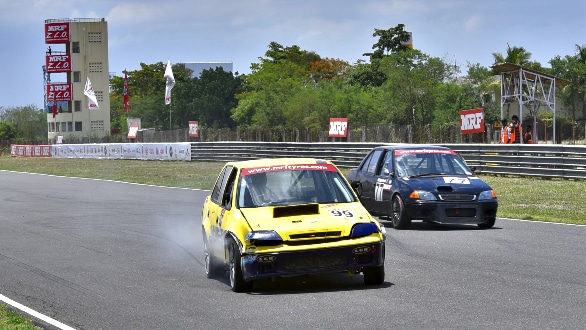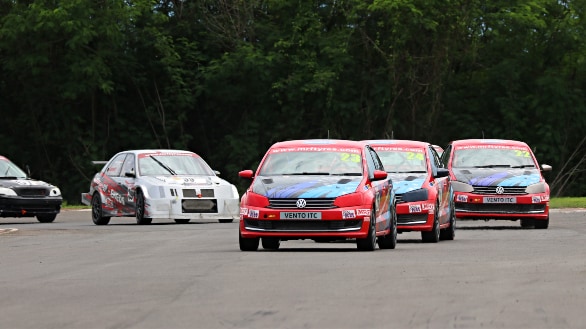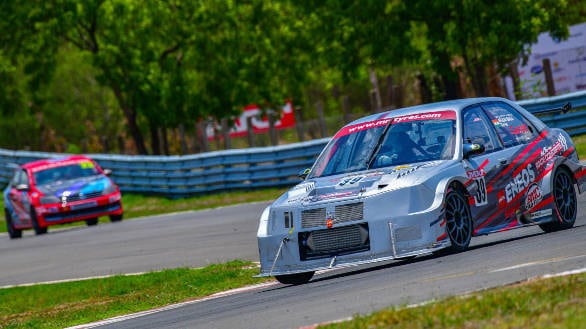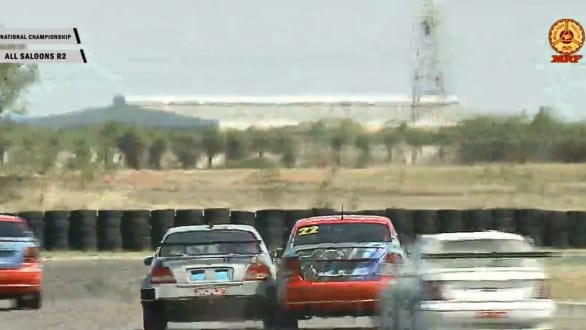2019 ITC Round 2: What is hard racing, after all?
Saloon racing in India has, on more than one occasion, been likened to bumper cars. Whether it was the premier class of Indian Touring Cars, or super competitive Indian Junior Touring Cars class, drivers gave no quarter. I remember making the drive from Bangalore to Coimbatore in 2007, with a college friend who'd convinced his dad that stripping out the family's Esteem and taking it racing was a good idea. Except, after the first race, he pulled back into the pits with what looked like half a car - bumpers dragging across the tarmac, mangled body panels and smashed tail lights. While we were thinking of new ways to phrase our then-limited vocabulary of expletives, the team mechanics pulled out hammers and got to work. It was just the way it had always been.
 Raghul Rangaswamy (No. 99) had a shunt himself in Race 1, putting his Esteem out of the reckoning
Raghul Rangaswamy (No. 99) had a shunt himself in Race 1, putting his Esteem out of the reckoning
The top drivers came prepared to trade paint, get pushed around and to push back. Because if you weren't, you weren't likely to stay in the top, whether you had the pace or not. Even in international series, like the British Touring Car Championship, you wouldn't get past a weekend without hearing the phrase 'rubbing is racing' because it's next to impossible to have a high level of competition without some contact. Sometimes, the contact pays off and sometimes it gets drivers awarded penalties but motor racing isn't meant to be polite doors aren't held open for you, they're sometimes slammed shut instead. At the end of the day, it's the close racing that keeps us coming back for more and the stewards have the heavy responsibility of drawing the line between close and dangerous.

Over the years, a lot more discipline has entered tarmac racing, in India at least. It could be down to anything from shrunken grids to less competitive drivers, or even perhaps, more (financially?) aware drivers, most of whom are privateers. So when the lights went out on the first saloon car race on Sunday, I expected to see a clean race of a grid that just had eight ITC cars on it. For the four cars at the top the three factory VW Motorsport Ventos, and Race Concepts' recently turbocharged Honda City it was the last chance of the weekend to prove a point, though. Since the last round, where the Ventos had a clean sweep of the podium, Team Race Concepts had fixed all their teething issues and were strong in the previous day's race. But a reverse grid had Race Concepts' veteran driver Arjun Balu start behind Karthik Tharani in the Vento, a position Tharani tried to hold him in through the course of the eight-lap race. And thus began one of the best, and closest fought, bits of racing I can remember.
 Arjun Balu (No. 39), finished Race 1 with a 9 sec lead over Karthik Tharani (No. 22)
Arjun Balu (No. 39), finished Race 1 with a 9 sec lead over Karthik Tharani (No. 22)
With the Race Concepts' City in fine form, it was lapping over two seconds quicker than the Ventos. While you would think that would make for easy pickings, Tharani held on ahead of Balu with driving which just about toed the lines of the rulebooks. A driver is allowed to make one defensive move in one direction to hold his place, or to prevent the attacking driver from benefitting from a slipstream. On one lap, Tharani seemingly made two moves in either direction on the start-finish straight. A quick chat with Balu post the race shows his sentiment is clear, perhaps even warranted from his point of view, "I don't expect this kind of driving from a factory driver (Tharani) because you can see he was weaving down the straight and blocking me."
While weaving is illegal and grounds for a penalty, there is an acceptable loophole in the one-move rule. If the defending driver's second move coincides with lining up his car to the racing line, the move is allowed if the defender leaves a one car width to the edge of the track for the attacker. At this race, the stewards seem to have opined in Tharani's favour. "The Race Concepts car is two seconds faster than us but my job as a racing driver is to not allow anyone to pass me my job is to stay ahead. The Honda is really quick but we have the speed on the straights and he (Balu) couldn't get ahead," Tharani says, full of nervous energy after the race.

It's not the only incident he's left to defend. Midway through the battle, Balu manages to get his car alongside Tharani's, around the outside of C1. There was contact as Tharani took the racing line from the exit of C1 into C2, narrowly holding onto the lead. In this situation, the FIA regulations state that if both cars are approximately halfway alongside, the blame for contact could go either way. But the rules do clarify that if the driver on the inside is behind at corner exit, he must leave space for the attacker to go around the outside. On the other hand, if the driver on the inside is ahead, it's the attacker's duty to back off to avoid collision. It's most usually categorised as a racing incident and left at that, like it was in this case, since neither driver would want to back off.

Unfortunately for Tharani, the stewards had to draw the line at his ignoring a drive-through penalty and subsequent black flag situation. "I had an eye on my mirrors to see where the Honda was coming onto the straight, and I guess I just kept missing the penalty board at the end of the pit lane. After the race, I come in first and they tell me I had a black flag. It was completely my fault, and I have no excuses for missing it. I'm sorry to the whole team for this." Tharani is understandably apologetic. More so because the stewards decided to make a point of their own, stripping Tharani of his victory and serving him a one race ban, as he is also a driver coach for the Ameo Cup drivers.
 Cracker of a season opener for Tharani (No. 22), with a double victory for the VW Motorsport team, out of three wins overall for the team at Round 1 of the ITC at Kari, Coimbatore
Cracker of a season opener for Tharani (No. 22), with a double victory for the VW Motorsport team, out of three wins overall for the team at Round 1 of the ITC at Kari, Coimbatore
It's a heavy price to pay. Having to sit out Round 3 held mid-August, Tharani lost his lead in the ITC championship, while Balu's double victories and his VW Motorsport teammate Dhruv Mohite's consistency put them both ahead of him in the points. In his place, Aditya Patel was brought in as a guest driver, and had his own battle in the wet with Balu in Race 1, which was ultimately won by Balu. The other two races of the weekend saw Patel come in second after Mohite in one race, and second after Balu in the other. While the championship would appear to be a lost cause for Tharani, there's still hope for the VW Motorsport team. With more potential to be unlocked in the handling of the Vento ITC, we can at least be sure of one thing more close racing than ever before between the quickest saloon cars India has ever seen.
Starts Rs 10.9 Lakhs
1497cc
Manual
100
145
17.8 Kmpl












